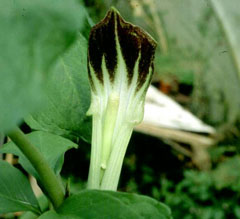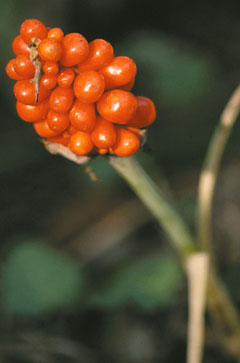 |
|
(c) 2010 Ken Fern & Plants For A Future |
 |
|
Translate this page:
Summary
Bloom Color: Green, Purple, White
Main Bloom Time: Late spring, Mid spring. Form: Upright or erect.
Physical Characteristics

 Arisaema triphyllum is a PERENNIAL growing to 0.6 m (2ft) by 0.5 m (1ft 8in) at a slow rate.
Arisaema triphyllum is a PERENNIAL growing to 0.6 m (2ft) by 0.5 m (1ft 8in) at a slow rate.
See above for USDA hardiness. It is hardy to UK zone 4. It is in flower from June to July. The species is dioecious (individual flowers are either male or female, but only one sex is to be found on any one plant so both male and female plants must be grown if seed is required). and is pollinated by Flies. The plant is not self-fertile.
Suitable for: light (sandy) and medium (loamy) soils and prefers well-drained soil. Suitable pH: mildly acid, neutral and basic (mildly alkaline) soils. It can grow in full shade (deep woodland) semi-shade (light woodland) or no shade. It prefers moist soil.
UK Hardiness Map
US Hardiness Map
Synonyms
A. atrorubens. Blume. Arum triphyllum.
Plant Habitats
Woodland Garden Dappled Shade; Shady Edge; not Deep Shade;
Edible Uses
Edible Parts: Root
Edible Uses:
Tuber - it must be thoroughly dried or cooked before being eaten[2, 21, 55, 57, 95, 102]. The roots can be cut into very thin slices and allowed to dry for several months, after which they are eaten like potato chips, crumbled to make a cereal or ground into a cocoa-flavoured powder for making biscuits, cakes etc[177, 183]. They can also be pounded into a powder, this is thern left to dry for several weeks when it becomes safe to use[213]. The root is up to 5cm long and 2cm wide[4]. Caution is advised, see the notes above on toxicity.
References More on Edible Uses
Medicinal Uses
Plants For A Future can not take any responsibility for any adverse effects from the use of plants. Always seek advice from a professional before using a plant medicinally.
Acrid Antirheumatic Antiseptic Contraceptive Diaphoretic Expectorant Irritant Poultice
Stimulant
The root is acrid, antiseptic, diaphoretic, expectorant, irritant and stimulant[21, 46, 222, 238, 257]. It is harvested in early spring and dried for later use[4]. The fresh root is considered to be too dangerous and intensely acrid to use, whilst the dried roots become inactive, so fresh, partially dried roots are used[213]. Due to the potentially toxic nature of this plant, it should only be used internally under the supervision of a qualified practitioner[K]. The root was applied as a poultice on headaches, scrofulous sores, rheumatism, boils, abscesses and ringworm[222, 257]. A decoction of the root has been used as a wash for sore eyes[257]. The root was used as a contraceptive by the N. American Indians. One teaspoonful of the dried powdered root in cold water was said to prevent conception for a week whilst two teaspoonfuls in hot water was said to induce permanent sterility[213].
References More on Medicinal Uses
The Bookshop: Edible Plant Books
Our Latest books on Perennial Plants For Food Forests and Permaculture Gardens in paperback or digital formats.

Edible Tropical Plants
Food Forest Plants for Hotter Conditions: 250+ Plants For Tropical Food Forests & Permaculture Gardens.
More

Edible Temperate Plants
Plants for Your Food Forest: 500 Plants for Temperate Food Forests & Permaculture Gardens.
More

More Books
PFAF have eight books available in paperback and digital formats. Browse the shop for more information.
Shop Now
Other Uses
Musical Starch
A starch obtained from the roots is used as a stiffener for clothes[207]. It is very harsh to the hands, causing blisters and swellings[207]. The seeds have been used in rattles[257].
Special Uses
References More on Other Uses
Cultivation details
Landscape Uses:Massing, Woodland garden. Prefers a cool peaty soil in the bog garden, woodland garden or a sheltered border in semi-shade[90, 134, 200]. Prefers a loamy or peaty soil and will tolerate a sunny position if the soil is moist but not water-logged and the position is not too hot or exposed[1, 200]. Tubers should be planted about 10cm deep[233]. Only plant out full sized tubers and mulch them with organic matter in the winter[200]. Plants need protection from slugs[200]. Most species in this genus are dioecious, but they are sometimes monoecious and can also change sex from year to year. Special Features:
Attracts birds, Attractive foliage, North American native, Naturalizing, All or parts of this plant are poisonous, Wetlands plant.
References Carbon Farming Information and Carbon Sequestration Information
Temperature Converter
Type a value in the Celsius field to convert the value to Fahrenheit:
Fahrenheit:
The PFAF Bookshop
Plants For A Future have a number of books available in paperback and digital form. Book titles include Edible Plants, Edible Perennials, Edible Trees,Edible Shrubs, Woodland Gardening, and Temperate Food Forest Plants. Our new book is Food Forest Plants For Hotter Conditions (Tropical and Sub-Tropical).
Shop Now
Plant Propagation
Seed - best sown as soon as it is ripe in a shady position in a cold frame[134]. Stored seed remains viable for at least a year and can be sown in spring in the greenhouse but it will probably require a period of cold stratification. Germination usually takes place in 1 - 6 months at 15°c[134]. When large enough to handle, prick the seedlings out into individual pots and grow them on in light shade in the greenhouse for at least a coupe of years until the corms are more than 20mm in diameter. Plant out into their permanent positions whilst they are dormant. Division of tubers when the plant dies down in late summer.
Other Names
If available other names are mentioned here
Native Range
NORTHERN AMERICA: Canada (Québec (south), Nova Scotia, Ontario (south), Prince Edward Island, New Brunswick, Manitoba (southeast)), United States (Connecticut, Indiana, Maine, Massachusetts, Michigan, New Hampshire, New Jersey, New York, Ohio, Pennsylvania, Rhode Island, Vermont, West Virginia, Illinois, Iowa, Kansas (east), Minnesota, Missouri, Nebraska (east), North Dakota (east), Oklahoma (east), South Dakota (east), Wisconsin, Alabama, Arkansas, Delaware, Florida, Georgia, Kentucky, Louisiana, Maryland, Mississippi, North Carolina, South Carolina, Tennessee, Virginia, District of Columbia, Texas)
Weed Potential
Right plant wrong place. We are currently updating this section.
Please note that a plant may be invasive in one area but may not in your area so it's worth checking.
Conservation Status
IUCN Red List of Threatened Plants Status :

Growth: S = slow M = medium F = fast. Soil: L = light (sandy) M = medium H = heavy (clay). pH: A = acid N = neutral B = basic (alkaline). Shade: F = full shade S = semi-shade N = no shade. Moisture: D = dry M = Moist We = wet Wa = water.
Now available:
Food Forest Plants for Mediterranean Conditions
350+ Perennial Plants For Mediterranean and Drier Food Forests and Permaculture Gardens.
[Paperback and eBook]
This is the third in Plants For A Future's series of plant guides for food forests tailored to
specific climate zones. Following volumes on temperate and tropical ecosystems, this book focuses
on species suited to Mediterranean conditions—regions with hot, dry summers and cool, wet winters,
often facing the added challenge of climate change.
Read More
Expert comment
Author
(L.)Schott.
Botanical References
43200
Links / References
For a list of references used on this page please go here
Readers comment